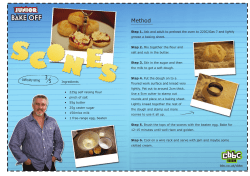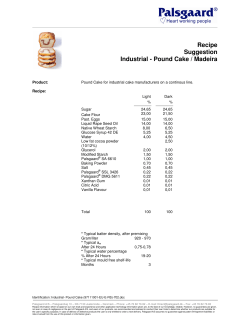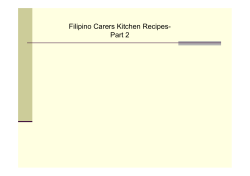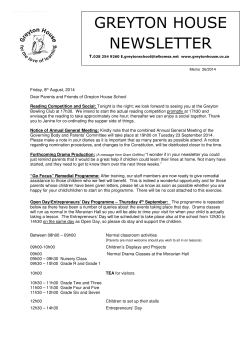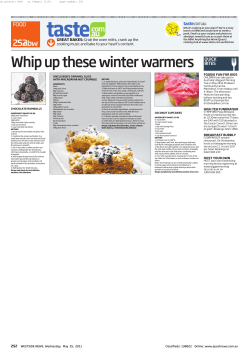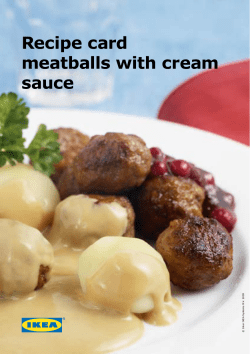
Baking tips from The Hummingbird Bakery
Baking tips from The Hummingbird Bakery Thank you for purchasing The Hummingbird Bakery Cookbook! Most of our recipes have been collected from old friends and relatives, so they come from a variety of sources and use many different cooking methods. We have modified them so that they will turn out exactly as they do in our shops, picking the goodies that sell the most when we put them out on our shelves. They are our take on good, old‐fashioned American favourites: nothing fancy, just very tasty treats! We have some tips which we hope will help you to get the best results from our recipes: • Sounds simple, but please do follow the recipes exactly as written! Baking is a chemical reaction, and so any experimentation with the recipe amounts can potentially cause a recipe to fail. • Some of our baking methods may seem unconventional to experienced bakers, but the recipes will work if followed exactly. • Don’t rush when measuring out ingredients and following the cooking method. In haste, we can all forget to measure out or add a certain ingredient! • Only use the correctly sized tin! If you put the whole batter amount into a tin that is too small, then the batter will overflow. Only ever fill the tin you have two‐thirds full. • For our ring cakes we recommend using: Wiltons Ring Mould (product code 2105‐4013) which, in the UK, can be purchased at Knightsbridge PME http://www.cakedecoration.co.uk/ among other places. • For our cupcake cases, please use ‘muffin cases’ from Waitrose, Lakeland Limited or other supermarkets. • For the muffin recipes, use ‘large muffin cases’. • Only ever fill cupcake cases two‐thirds full. • Muffin cases can be filled three‐quarters full but may overflow a little and create a ‘muffin top’! This is normal. • When creaming butter and sugar together, always make sure you do this until the mixture is light and fluffy, usually at least a good 5 minutes. • After adding flour to a mixture, don’t overbeat as this will overwork the flour and make the cake dense. Simply beat or stir until the flour is just incorporated. • Get an oven thermometer that you can hook into your oven permanently. This ensures that your oven temperature is accurate and well calibrated. • Ovens vary greatly, so use our suggested cooking times as a rough guide. First bake to the shorter cooking time, and then check every few minutes until finished. • Cakes, cupcakes and muffins are only ready when a skewer comes out clean when inserted. They are not automatically ready when the recommended time is up! • Please don’t open your oven until at least the minimum recommended time has passed. The more items baking at the same time, the longer the baking time might be. Too much cold air coming in from an open oven door can cause cakes to sink or not rise properly. • Make sure that your baking powder and bicarbonate of soda have not passed their best before date. • Please don’t substitute self‐raising flour for plain flour – this will affect the outcome of the recipe! • A good‐quality cocoa powder, such as Green & Blacks, is preferred. Weaker cocoa powders may produce inferior results. 1 of 5 Corrections to The Hummingbird Bakery Cookbook: 2 errors did creep in during the writing and publishing process (for the Lemon and Poppy Seed Cake, and the Lemon Loaf). These have been corrected in later editions. 1. Lemon and Poppy Seed Cake For a 25‐cm tin: • Plain flour: use 350 g. All other ingredients and method remain the same. • Bake for around 30 minutes, or until a skewer inserted comes out clean. For a 24‐cm tin: • We have also included a reduced version of the recipe, which will fit into a smaller, 24‐cm tin. (Please see amended recipe below.) 2. Lemon Loaf • Please reduce the Plain flour amount to 350 g. All other ingredients remain the same. • Bake for around 1 hour 15 minutes, or until a skewer inserted comes out clean. (Please see amended recipe below.) Further revisions: 1. Red Velvet Cupcakes: The recipe has been edited to work with a specific type of food colouring that we now recommend, as it produces results closest to those in our shops. • Please use Dr Oetker Red Colouring, NOT the ‘Natural Red’ or ‘Scarlett’ as those will make the cake come out a brownish colour. Dr Oetker can be found at Sainsbury’s and online. • Reduce the red colouring amount to 1 small bottle (around 20 ml) • Reduce the cocoa powder amount to 10 g to compensate. • All other ingredients and method remain the same. • (Please see amended recipe below.) 2. Brooklyn Blackout Cake The custard for this recipe is tricky to make, so here are some tips: • This custard does turn out quite thick – this is so that it can hold the sponges in place and the cake won’t slide around! It is not a light, airy frosting, but dense and chocolatey. • Use the indicated 200 g cornflour. • Add 120–200 ml water to the cornflour, whisking briskly as you add the water. • If you feel the mixture is too solid or thick, you can add more water slowly, up to about 250 ml in total. You must whisk constantly to get the lumps out of the mixture. • The cornflour/water mixture should be the consistency of thick glue or wallpaper paste. • When you add the cornflour/water mixture to the cooking cocoa, water, sugar and golden syrup mix, make sure you are on a medium heat and NOT a high heat, and whisk constantly. • Cook and whisk the combined mixture until it bubbles/boils and is quite thick, i.e. a few minutes. • Then continue with the method as written. 2 of 5 lemon and poppy seed cake A moist, tangy cake that is perfect with your afternoon cup of tea. 85 g unsalted butter, at room temperature 245 g caster sugar grated zest of 1½ unwaxed lemons 15 g poppy seeds, plus extra to decorate 165 ml whole milk 235 g plain flour Preheat the oven to 170°C (325°F) Gas 3. Put the butter, sugar, lemon zest and poppy seeds in a freestanding electric mixer with a paddle attachment (or use a handheld electric whisk) and beat until all the ingredients are well incorporated (don’t worry if the mixture looks slightly split). Slowly add the milk and continue to beat until incorporated (don’t worry if the mixture looks slightly split). 2 teaspoons baking powder In a separate bowl, combine the flour, baking powder and ½ teaspoon salt salt. Add the flour mixture to the butter mixture in 3 additions, 3 egg whites scraping any unmixed ingredients from the side of the bowl with a rubber spatula after each addition. Beat thoroughly lemon syrup until all the ingredients are well incorporated and the mixture freshly squeezed juice and zest of 1 lemon is light and fluffy. 50 g caster sugar In a separate bowl, whisk the egg whites with a handheld electric whisk until stiff peaks form. Using a metal spoon, lemon glaze fold the whisked egg whites into the cake mixture until well freshly squeezed juice of 1 lemon mixed but do not overmix. Pour into the prepared ring mould 250 g icing sugar, sifted and smooth over with a palette knife. Bake in the preheated oven for about 30 minutes, or until the sponge bounces back a 24-cm ring mould, greased and dusted with flour Makes 12–16 slices when touched. For the lemon syrup: While the cake is baking, put the lemon juice and zest, sugar and 100 ml water in a small saucepan and bring to the boil over low heat. Raise the heat and boil until it has reduced by half, or until it has a thin syrup consistency. When the hot cake comes out of the oven, pour the syrup all over the top. Leave to cool slightly in the mould before turning out onto a wire cooling rack to cool completely. For the lemon glaze: Mix the lemon juice and icing sugar in a bowl until smooth. It should be thick but pourable – add a little water or more sugar to thin or thicken as necessary. When the cake is cold, put it on a cake stand, pour the glaze over it and decorate with poppy seeds. cakes 57 lemon loaf When drizzled with the lemon syrup, this is incredibly moist, tangy and flies off our counter when served in the shop. 320 g caster sugar 3 eggs Preheat the oven to 170°C (325°F) Gas 3. Put the sugar, eggs and lemon zest in a freestanding electric grated zest of 2 unwaxed lemons mixer with a paddle attachment (or use a handheld electric 350 g plain flour whisk) and beat until well mixed. 1½ teaspoons baking powder 1 teaspoon salt 250 ml whole milk Sift the flour, baking powder and salt into a separate bowl. Combine the milk and vanilla extract in another bowl. Add one-third of the flour mixture to the sugar mixture and beat well, ½ teaspoon vanilla extract then beat in one-third of the milk mixture. Repeat this process 200 g unsalted butter, melted twice more until everything has been added. Turn the mixer lemon syrup up to high speed and beat until the mixture is light and fluffy. freshly squeezed juice and zest of 1 lemon Turn the mixer down to low speed, pour in the melted butter 50 g caster sugar and beat until well incorporated. Pour the mixture into the prepared loaf tin and bake in the a 23 x 13-cm loaf tin, greased and dusted with flour preheated oven for about 1 hour 15 minutes, or until golden Makes 8–10 slices For the lemon syrup: While the cake is baking, put the lemon brown and the sponge bounces back when touched. juice and zest, sugar and 100 ml water in a small saucepan and bring to the boil over low heat. Raise the heat and boil until it has reduced by half, or until it has a thin syrup consistency. When the hot cake comes out of the oven, put it on a wire cooling rack in the sink and pour the syrup all over the top. The excess syrup will run over the edges into the sink. Leave to cool slightly in the tin before turning out onto the wire cooling rack to cool completely. cakes 71 red velvet cupcakes It seems people can’t resist the red velvet cupcakes’ deep red sponge with white Cream Cheese Frosting. Mix all the ingredients well so that the sponge has an even colour and texture. Red food colourings vary in strength, but we recommend Dr. Oetker Red Food Colouring for the best result. To make a red velvet cake instead, double the quantities below, divide between three 20-cm cake tins and bake for 25 minutes at the same oven temperature. Frost with 2 quantities of Cream Cheese Frosting. 60 g unsalted butter, at room temperature 150 g caster sugar 1 egg 10 g cocoa powder Preheat the oven to 170°C (325°F) Gas 3. Put the butter and the sugar in a freestanding electric mixer with a paddle attachment (or use a handheld electric whisk) and beat on medium speed until light and fluffy and well mixed. Turn the mixer up to high speed, slowly add the egg and beat 20 ml red food colouring (preferably Dr. Oetker Red Food Colouring) until everything is well incorporated. ½ teaspoon vanilla extract In a separate bowl, mix together the cocoa powder, red food 120 ml buttermilk colouring and vanilla extract to make a thick, dark paste. Add 150 g plain flour to the butter mixture and mix thoroughly until evenly combined ½ teaspoon salt ½ teaspoon bicarbonate of soda 1½ teaspoons white wine vinegar 1 quantity Cream Cheese Frosting (page 11) a 12-hole cupcake tray, lined with paper cases (see note on page 4) and coloured (scrape any unmixed ingredients from the side of the bowl with a rubber spatula). Turn the mixer down to slow speed and slowly pour in half the buttermilk. Beat until well mixed, then add half the flour, and beat until everything is well incorporated. Repeat this process until all the buttermilk and flour have been added. Scrape down the side of the bowl again. Turn the mixer up to high speed and beat until you have a smooth, even mixture. Turn the mixer down to low speed and add the salt, bicarbonate of soda and vinegar. Beat until well Makes 12 mixed, then turn up the speed again and beat for a couple more minutes. Spoon the mixture into the paper cases until two-thirds full and bake in the preheated oven for 20–25 minutes, or until the sponge bounces back when touched. A skewer inserted in the centre should come out clean. Leave the cupcakes to cool slightly in the tray before turning out onto a wire cooling rack to cool completely. When the cupcakes are cold, spoon the Cream Cheese Frosting on top. See photographs on pages 18 and 19. 20 cupcakes
© Copyright 2025

